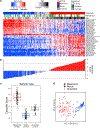Identification of a Robust Methylation Classifier for Cutaneous Melanoma Diagnosis
- PMID: 30529013
- PMCID: PMC6535139
- DOI: 10.1016/j.jid.2018.11.024
Identification of a Robust Methylation Classifier for Cutaneous Melanoma Diagnosis
Abstract
Early diagnosis improves melanoma survival, yet the histopathological diagnosis of cutaneous primary melanoma can be challenging, even for expert dermatopathologists. Analysis of epigenetic alterations, such as DNA methylation, that occur in melanoma can aid in its early diagnosis. Using a genome-wide methylation screening, we assessed CpG methylation in a diverse set of 89 primary invasive melanomas, 73 nevi, and 41 melanocytic proliferations of uncertain malignant potential, classified based on interobserver review by dermatopathologists. Melanomas and nevi were split into training and validation sets. Predictive modeling in the training set using ElasticNet identified a 40-CpG classifier distinguishing 60 melanomas from 48 nevi. High diagnostic accuracy (area under the receiver operator characteristic curve = 0.996, sensitivity = 96.6%, and specificity = 100.0%) was independently confirmed in the validation set (29 melanomas, 25 nevi) and other published sample sets. The 40-CpG melanoma classifier included homeobox transcription factors and genes with roles in stem cell pluripotency or the nervous system. Application of the 40-CpG melanoma classifier to the diagnostically uncertain samples assigned melanoma or nevus status, potentially offering a diagnostic tool to assist dermatopathologists. In summary, the robust, accurate 40-CpG melanoma classifier offers a promising assay for improving primary melanoma diagnosis.
Copyright © 2018 The Authors. Published by Elsevier Inc. All rights reserved.
Conflict of interest statement
Figures



References
-
- Alexandrescu DT, Kauffman CL, Jatkoe TA, Hartmann DP, Vener T, Wang H, et al. Melanoma-specific marker expression in skin biopsy tissues as a tool to facilitate melanoma diagnosis. J Invest Dermatol 2010;130(7):1887–92. - PubMed
-
- Andtbacka RH, Kaufman HL, Collichio F, Amatruda T, Senzer N, Chesney J, et al. Talimogene Laherparepvec Improves Durable Response Rate in Patients With Advanced Melanoma. J Clin Oncol 2015;33(25):2780–8. - PubMed
-
- Arai E, Kanai Y. DNA methylation profiles in precancerous tissue and cancers: carcinogenetic risk estimation and prognostication based on DNA methylation status. Epigenomics 2010;2(3):467–81. - PubMed
-
- Baras A, Yu Y, Filtz M, Kim B, Moskaluk CA. Combined genomic and gene expression microarray profiling identifies ECOP as an upregulated gene in squamous cell carcinomas independent of DNA amplification. Oncogene 2009;28(32):2919–24. - PubMed
Publication types
MeSH terms
Substances
Grants and funding
LinkOut - more resources
Full Text Sources
Other Literature Sources
Medical
Molecular Biology Databases
Research Materials

